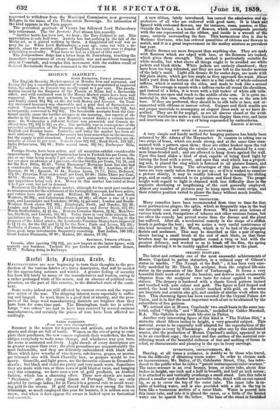PARIS FASHIONS.
(From our own Correspondent.)
Summer is the season for departures and arrivals, and in Paris the streets and shops are full of bustle. Women on the eve of going to com- plete their purchases, the new comers replenish their wardrobes, the heat obliges everybody to make some change, and whichever way you turn, the scene is animated and lively. Light shawls of every description are in greater request than ever; the plain grenadines are unquestionably the most fashionable, and they are delicately embroidered with black silk. Those which have wreaths of vine-leaves, oak-leaves, grapes, or acorns, are trimmed 'also with black Chantilly lace, as guipure would be too heavy. Groseille, and light green, are the favourite colours in Grenadine shawls ; but black and violet are pretty and very much worn. Sometimes they are made with two or three rows of gold braid or twist, and hanging over this trimming, we have seen a row of gold pendants, an Arabian fashion, which has a charming effect. These new shawls are named " Stephanie," after the young Queen of Portugal. They are only adopted by carriage ladies ; for in Paris it is a general rule to avoid wear- ing gold in the streets. If gold thread finds its way among the black trimmings, so much employed this year for bonnets, it is seldom seen on straw, and when it does appear the owner is looked upon as fantastical and eccentric.
A new ribbon, lately introduced, has earned the admiration and ap- probation of all who are endowed with good taste. It is black and figured with embossed flowers, say for instance, roses, pansies, or lilac. Outside the bonnet, is a bunch of flowers, which corresponds precisely with the one represented on the ribbon, and inside is a wreath of the same, entirely surrounding the face. This harmonious idea is due to Madame Gervaiae, who has ordered quantities of ribbons and flowers to match, and it is a great improvement on the motley mixture so prevalent last year.
Muslin dresses are more frequent than anything else. They are made with flounces which are edged with lace, or the flounces are tucked, which gives them strength. This method is particularly suitable for white muslin, but what above all things ought to be avoided are white
hackets and black skirts. White jackets are entirely abandoned; they ave been too long tolerated, and they are now left to the tender mercies of the lady's maid. Light silk dresses fit for cooler days, are made with full plain skirts, which get less ample as they approach the waist. About half a yard from the bottom of the skirt is a flat ruche of whole-coloured taffetas, which is carried up the sides, and made to look like a second skirt. The corsage is square with a taffetas ruche all round the shoulders, and instead of a fichu, it is worn with a full tucker of white silk tulle. The sleeves are open and reach to the middle of the arm. It is quite im- material in this ease, whether under sleeves are worn or the arm left bare. If they are preferred, they should be in silk tulle or lace, and or- namented with ribbons or narrow velvet. Guipure and thick muslin are not proper materials to accompany an elegant dress such as we have de- scribed. They are fit for neglige, as are all sleeves closed at the wrist. Our linen warehouses make a more luxurious display than ever, and laces and insertions are in a fair way of being superseded by embroideries.
LEONIE D'AUNET.


































 Previous page
Previous page